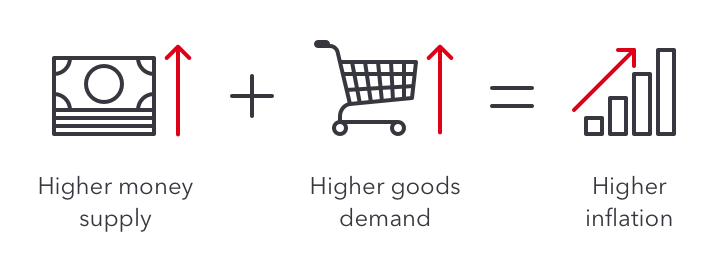Relationship Inflation, Annuity & Mutual Fund Returns An In-Depth Look at the Correlation Between Inflation and Annuity Mutual Fund Returns.
Have you ever wondered how your annuity mutual fund investments are affected by inflation? Do you wish to know more about the correlation between inflation and returns on those funds? If so, then this article is for you! It delves into an in-depth look at the relationship between inflation and annuity mutual fund returns. Exploring the Relationship Inflation, Annuity & Mutual Fund Returns
Inflation is a significant economic factor that affects every sector of the economy, including investments such as annuity mutual funds. To make informed decisions about which funds to invest in, it’s essential to understand what role inflation plays in affecting returns. This article will explain precisely how inflation influences mutual fund performance, giving readers all the information they need to make intelligent investment choices. Exploring the Relationship Inflation, Annuity & Mutual Fund Returns. read more
Finally, we’ll also discuss some strategies investors can use to minimize the impact of inflation and maximize their profits from annuity mutual fund investments. So if you’re ready to learn more about this vital topic, keep reading! Exploring the Relationship Inflation, Annuity & Mutual Fund Returns.

Definition of Inflation and Annuity Mutual Funds
Inflation and annuity mutual funds are two terms intertwined in finance. But do they genuinely have a connection? Well, this article will explore their correlation to help us find out! Let’s start by defining these concepts before we dive into historical data analysis. Exploring the Relationship Inflation. read more
When it comes to inflation, it is defined as an increase in prices or the general level of prices within an economy over some time. The rate at which this occurs is typically calculated using consumer price index (CPI) figures gathered from different sectors, such as housing costs, transportation fees, and food expenses. This phenomenon seriously impacts how people save money since purchasing power decreases with increasing prices.
An annuity fund is an investment vehicle where investors pool their money and use it to purchase fixed-income products such as bonds or treasuries. These investments generate cash flow through interest payments made by the issuer of the securities purchased by the fund manager. Additionally, economic theories suggest that returns from annuity mutual funds should be higher than those from regular stock market investments due to their ability to absorb losses during periods of high inflation rates. Exploring the Relationship Inflation
Now that we understand what each term means let’s explore how their relationship affects global financial markets. Exploring the Relationship Inflation. read more
Historical Data Analysis
We must analyze historical data to understand better the correlation between inflation and annuity mutual fund returns. To do this, let’s look at the U.S. inflation rate over the past ten years compared to the performance of various types of mutual funds. We can see that while some investments have had above-average returns in times of higher inflation rates, others have struggled due to increased expenses related to rising prices. Different types of mutual funds may be more or less vulnerable to changes in the cost of living, depending on their investment strategies. Exploring the Relationship Inflation. read more
For example, when analyzing an annuity investment portfolio, it is essential to note that there are two primary sources of return: interest earned from the principal invested and capital gains resulting from stock market movements. While both are affected by inflation, the latter tends to be more volatile and, therefore, subject to more significant swings in value than cash reserves held as part of an annuity policy. Consequently, when evaluating your portfolio, it is vital to consider current economic conditions and how those conditions could affect future returns. Exploring the Relationship Inflation.
By taking into account both short-term trends, such as recent price increases, and long-term patterns, like multi-year cycles, investors can gain valuable insight into which type of mutual fund might provide them with adequate protection against inflationary pressures while still delivering competitive yields over time. With these considerations in mind, let’s focus on the risk factors associated with investing in annuities and other financial products. Exploring the Relationship Inflation. read more
Risk Factors
Ah, risk factors—the joy of investing. What would we do without them? Risk management is an essential part of any financial portfolio, and understanding inflation risks in annuity mutual funds can help investors make informed decisions about their investments. Exploring the Relationship Inflation. read more
When assessing the risk of annuity mutual fund investments, several key areas need to be considered: portfolio risk, liquidity risk, market risk, and inflation risk. Portfolio risk refers to how much exposure a particular investment has to various asset classes, which include stocks, bonds, commodities, and currencies. Liquidity risk assesses the ability of an investor to access cash quickly should they need it. Market risks refer to the volatility of prices within a given sector or overall economy over time. Lastly, inflation risks focus on changes in purchasing power due to price increases or decrease in goods and services over time. Exploring the Relationship Inflation.
Investors need to understand these different types of risks when considering annuity mutual fund investments, as they all play a role in determining the potential returns from such investments. It’s also crucial for investors to assess their circumstances before deciding to invest in annuity mutual funds. Understanding the pros and cons associated with such investments helps inform better decision-making when choosing which type of investment best suits one’s needs and objectives. Exploring the Relationship Inflation.
Pros and Cons of Investing in Annuity Mutual Funds
Investing in annuity mutual funds can be a great way to diversify one’s assets and create an effective investment strategy. These funds offer investors the potential to earn higher returns than traditional fixed-income investments while providing some protection against inflation. However, certain risks are associated with investing in annuity mutual funds that must be considered before making any decisions. Exploring the Relationship Inflation.
Advantages of investing in annuity
One of the key advantages of investing in annuity mutual funds is their ability to provide reliable income and stability over time. This fund pays out regular dividends, which helps offset losses due to market volatility or other economic conditions. read more
Additionally, many annuity mutual funds offer tax benefits for those who qualify, allowing them to save money on taxes throughout the year. Furthermore, these types of funds often have low management fees, making them attractive for investors looking for long-term growth opportunities without having to pay high fees upfront. Exploring the Relationship Inflation.
On the other hand, some drawbacks are also associated with investing in annuity mutual funds. For instance, since these investments involve more risk than traditional fixed-income vehicles such as bonds or CDs, they may not provide adequate protection against inflationary pressures over the long term.
Additionally, many annuity mutual funds require significant initial investments that may only be suitable for some investors. Finally, it is essential to note that while these types of investments can provide excellent returns over time if appropriately managed, they come with some risk and should only be used as part of a more extensive financial portfolio after the investor has given careful consideration. Exploring the Relationship Inflation.
To make wise investment choices when considering annuity mutual funds, it is crucial for investors to weigh both the pros and cons before deciding whether or not this type of fund will fit into their overall goals and objectives. By understanding how each factor impacts performance and return potential, investors can better determine appropriate investment strategies based on their situation and needs. With this knowledge, individuals can then decide if investing in annuity mutual funds is right for them and begin building a viable portfolio that considers expected inflation levels along with current market trends. Exploring the Relationship Inflation. read more
Impact of Inflation On Annuity Mutual Fund Returns
An interesting statistic is that inflation has averaged approximately 2.2% annually over the past ten years. This can have significant implications for annuity mutual fund returns because it affects how much purchasing power investors can maintain with their investments. Exploring the Relationship Inflation.
When the inflation rate increases, the value of money decreases, which means that investors may receive a lower return on their investments than they would during times of low inflation. As a result, annuity mutual funds may see lower returns than other investment options in periods of higher inflation. On the other hand, if inflation is low, these funds could produce higher returns than those available from different types of investments since there will be less pressure on prices and, thus, more opportunities for profits. Exploring the Relationship Inflation.
In addition to affecting returns directly, inflation can also cause changes in economic conditions, which can indirectly impact annuity mutual fund performance. For example, suppose an economy is experiencing deflation, a period of falling prices. In that case, investors may become less willing to invest in riskier assets such as annuities since they will expect lower returns compared to safer alternatives like cash or government bonds. Similarly, suppose an economy experiences hyperinflation (very high rates of price increases). In that case, people may prefer investing in tangible goods rather than financial instruments like annuities since they will expect more significant gains from real estate or commodities than stocks or bonds. Exploring the Relationship Inflation.
These examples demonstrate how changes in overall economic conditions can influence investor decisions when choosing where to allocate their capital and consequently affect returns generated by annuity mutual funds. Thus, understanding the relationship between inflation and economic activity is essential for a successful long-term investing strategy involving these types of securities. Exploring the Relationship Inflation. read more
Economic Conditions and Annuity Mutual Fund Returns
It is important to consider economic conditions when analyzing annuity mutual fund returns. As inflation rates rise, so do prices and the cost of living expenses, all while reducing the buying power of a dollar. Annuity mutual funds are susceptible to changes in inflation and market volatility because they have actively managed investments that require risk management and can be exposed to more risks than other investments. Exploring the Relationship Inflation.
The impact of economic conditions on annuity mutual funds can vary depending on the type of fund chosen. Funds with higher levels of risk may generate greater returns but also come with added volatility compared to low-risk funds, which tend to provide more consistent long-term results over time. Investors should weigh their options carefully when selecting an annuity mutual fund based on their financial goals and objectives.
In addition, it is essential for investors to stay informed about current events and macroeconomic indicators such as unemployment rates or GDP growth, which can have profound implications for both short-term gains and the long-term performance of annuity mutual funds. By understanding how various economic factors influence investment returns, investors will be better equipped to make sound portfolio decisions. With this information, investors can maximize potential gains while minimizing losses associated with annuity mutual funds over time.
This knowledge is a valuable tool when considering taxes and fees on annuity mutual funds since these costs can significantly reduce overall returns if not properly managed.
Taxes and fees On Annuity Mutual Funds
Regarding annuity mutual funds, taxes and fees are two components that must be considered. Taxes on any investment will take a cut from the potential return investors can expect. Annuity mutual funds are no different. An annual tax levied by the government is assessed based on the total returns gained throughout the year. Exploring the Relationship Inflation.
In addition to this annual fee, there could also be some additional fees associated with owning annuity mutual funds. These charges usually come in the form of management fees or administration costs, which may reduce the overall gains achieved through investments made within these funds. It’s essential for investors to understand what they’re being charged when purchasing shares within them so they can make sure their expected returns remain intact after factoring in all applicable taxes and fees.
Investors should also consider how their financial situation affects their ability to invest in annuity mutual funds, as certain deductions or credits could help lower taxes due at year’s end. Knowing the full scope of one’s circumstances allows for better decision-making when it comes to investing, thus helping maximize any potential profits earned from annuity mutual fund investments over time. As such, a comprehensive understanding of taxes and fees related to these specific investments is essential for achieving the desired results. With that said, let’s now discuss investment strategies for maximizing returns from annuity mutual funds.
Investment Strategies for Maximizing Returns
Making sound investment decisions for annuity mutual funds is not a guessing game; it requires careful analysis and research. To maximize returns while reducing risk, investors should consider various investment strategies to help them make the most of their investments. With a keen eye on economic conditions and trends, investors can take advantage of opportunities to improve their finances with annuity mutual funds.
One strategy for maximizing returns involves diversifying assets within an investor’s portfolio. Rather than investing solely in one type of asset or fund, spreading out investments across multiple types of assets reduces the overall risk associated with any single asset class. This may include stocks, bonds, real estate, cash equivalents, commodities, and derivatives. Additionally, investors should look into different types of annuity funds, such as money market accounts and CDs, which may have higher yields and lower fees than other options. By taking a comprehensive view of all available options when constructing an investment portfolio, investors can better manage the risks associated with market volatility while optimizing potential returns.
Another way to increase return on investments is by actively managing portfolios through rebalancing at least once per year or upon seeing significant changes in the markets or economy. When specific sectors experience growth faster than others, this technique allows investors to capitalize on these gains by shifting resources from underperforming segments toward those performing well. In addition to boosting profits from successful trades throughout the year, rebalancing prevents portfolios from becoming overly exposed to any specific sector or security over time so that risks are minimized even during periods where downturns frequently occur in some areas.
By utilizing diversification and active management approaches for annuity mutual funds, investors can effectively reduce risk while increasing yield compared to what would be possible if they only focused on one approach alone. Transitioning between strategies allows investors to adapt quickly to ever-changing market conditions while continuing to achieve maximum benefit from their financial endeavors.
Diversification of Assets To Reduce Risk
Diversification of assets is a critical component of mitigating risk when investing in annuity mutual funds. Asset diversification can include mutual fund diversification, portfolio diversification, and asset allocation. When investors opt for multiple types of investments, they mitigate the risk of investing in one class alone.
Mutual fund diversification involves spreading money across different sectors, such as stocks, bonds, real estate, or commodities, to reduce risk by minimizing volatility. Portfolio diversification consists of having various holdings from various sources to reduce overall investment risk and maximize returns on investment over time. Asset allocation refers to how much capital is allocated to each particular investment type so that the investor’s goals are met while adequately managing risk.
The goal behind these methods is to ensure that if one sector performs poorly, another might still be performing well and will balance out any losses. This form of financial planning allows investors to make wise decisions without being overly exposed to high-risk markets, which could potentially lead to significant losses. Through proper asset diversification practices, investors can protect themselves against market volatility and build wealth over the long term through sound investments.
With innovative asset management strategies like those discussed above, investors can decrease the risks associated with annuity mutual funds while also seeking higher returns on their investments.
Regulatory Requirements for Annuity Mutual Funds
Now that we have explored the correlation between inflation and annuity mutual fund returns, it is crucial to understand the regulatory requirements for these funds. According to a recent study, over 50% of all mutual fund regulations are related to annuities in some capacity. This indicates just how important it is for investors to be aware of the relevant investment regulations when purchasing an annuity mutual fund.
Investors must also be aware of any specific regulations related to their particular annuity plan or product. It is not enough to know the general investment guidelines; one must consider other areas, such as taxation rules, contribution limits, withdrawal restrictions, and more. The U.S. Securities and Exchange Commission (SEC) provides comprehensive information on its website regarding each state’s laws and regulations about annuities and mutual funds.
Additionally, financial advisors should always be consulted before deciding about investing in an annuity or mutual fund, as they can provide valuable advice regarding which plans may best suit your individual goals and needs. Ultimately, understanding the risks associated with investing in an annuity or mutual fund and the applicable legal framework will help ensure you make informed investment decisions.
Conclusion
In conclusion, investing in annuity mutual funds can be a great way to secure your retirement savings and guard against inflation. Despite the risks involved, there are specific strategies that can help minimize these risks while maximizing returns. With careful planning and diversification of assets, investors can mitigate their exposure to risk while still securing a solid return on their investments.
The key is understanding how inflation affects annuity mutual fund returns and adjusting investment strategies accordingly; this includes considering taxes and fees associated with different types of funds and researching historical data for performance trends over time. By carefully weighing all factors related to investing in annuity mutual funds, you can ensure you have a safe harbor from the raging seas of market uncertainty—a lighthouse guiding you toward.
Financial security
Ultimately, it’s up to each investor to determine if annuity mutual funds suit them. Still, done wisely, they can provide an invaluable tool for ensuring your future financial stability like nothing else can.











Leave a Reply